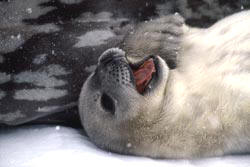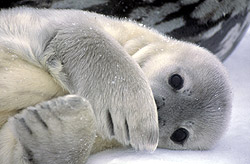Average Weight: 5kg - 11lb - feels more than this though when you've upset one and it's ran up and attacked you by hanging off your thigh muscle with its beak, like 5 bags of sugar dangling from a pair of pliers attached to your leg.
Average Height: 70cm - 27.5inches
Breeding Season: November - February - Adélie penguin colonies are very loud, raucous, busy and smelly affairs. The call of an adélie is as musical and gentle as a braying jackass and the whole colony is awash with guano (posh word for bird poop). When I was in Antarctica one thing I did was help with long-term surveys which entailed walking through the colony (terribly frowned upon these days). Each nest is just over two pecking distances apart so the penguins can't reach each other. Of course walking through the middle meant that you were in range of everyone. I used to worry a lot about falling over in a penguin colony, covered from head to toe in guano and pecked mercilessly.
Reproduction: Large colonies of up to half a million birds. Nests are lined with pebbles, and slightly higher than the surrounding land so that if the temperature rises and the snow melts, the nest is not flooded. The males arrive first on the nesting site at the beginning of the season and start the nest, then both partners work on the nest. Usually two eggs are laid, rarely three. Incubation of the first egg is 35 - 37 days, and the second chick is a few days behind the first. Male and female parent share egg and chick duty. Chicks are fed regurgitated krill (yum!) The chicks become independent at about two months old.
Estimated world population: - 5 million breeding pairs
Distribution: Circumpolar, tend to be found within the pack ice.
Oldest Rookery - At least 6,335 years old. The places where penguins nest together are called rookeries. These are started and later abandoned for reasons that are not entirely clear. Archaeological type studies have found that these rookeries are often continually used for many hundreds of years, even thousands. The oldest so far found has been used every year since well before 4 000 BC.
Adélie penguins are scared of: Leopard seals - main predators of adult birds, and Skuas - prey on eggs and chicks on land. They are not scared of the "Ice Man", "The Thing" or falling over on their backs and not being able to get up again - the first Antarctic "Urban Myth".
| 1/ Adélie penguins live further south than any other type. Why are these on the ice?. |
There are more Adélie penguins than any other penguin species. They live in the deep south and as such frequently have to cross many kilometres of ice still bound to the continent or islands to reach land in the spring where they can build their nests.
Sometimes they have to travel as much as 100 kilometres, though usually 20-40 is more usual. A long walk nevertheless.
This pair were early arrivals in spring at an Antarctic Island near the northern edge of their breeding range and only had about half a kilometre to waddle and "toboggan".
Tobogganing is a way of getting around where there is smooth snow or ice. The penguin lies on its stomach and propels itself along using its feet, an efficient use of energy and one where the penguin can easily keep up with a running man.
| 2/ When do adélie penguins start to nest? |
| 3/ Why are these penguins hopping about on the ice? |
| 4/ How long were they stuck? |
| 5/ Are there any problems in photographing penguins in these conditions? |
| 6/ Why is this penguin showing off? |
| 10/ Is this a penguin? Wait until his father gets home! |
When the parents go off to sea to catch fish for the chicks, the chicks have little to do other than stand around and try not to get into trouble. This doesn't always work in the way that it is supposed to, rather like human children, penguin chicks fall over sometimes and get a bit dirty!
1/ What are Weddell seals like?
| 2/ How do Weddell mothers look after their young? |
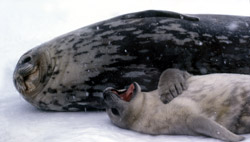 Newly born Weddell seal pups have to be some of the worlds cutest creatures as they flop about the ice in the early days after their birth, not able to co-ordinate their over-sized flippers before they grow into them. The mother arrives pregnant and with enough resources of blubber and protein to double the 25kg (55lb) birth weight of a pup in 10 days. She doesn't feed for about the first month and goes from an extremely plump barrel shape just before she gives birth - to a skinny shadow of her former self with ribs visible while the pup reverses the process. Newly born Weddell seal pups have to be some of the worlds cutest creatures as they flop about the ice in the early days after their birth, not able to co-ordinate their over-sized flippers before they grow into them. The mother arrives pregnant and with enough resources of blubber and protein to double the 25kg (55lb) birth weight of a pup in 10 days. She doesn't feed for about the first month and goes from an extremely plump barrel shape just before she gives birth - to a skinny shadow of her former self with ribs visible while the pup reverses the process. |
| 3/ Isn't it difficult for the pups to survive when they're born onto the ice? |
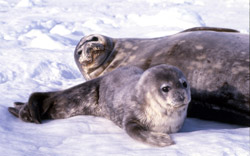 Weddell seal milk is one of the richest produced by any mammal. It contains about 60% fat (go and compare that to the label on the milk carton in the fridge) and it is this that is responsible for the rapid weight gain made by pups shortly after birth. The pups are weaned (stop drinking milk and begin eating normal seal food, i.e. fish) at around 7 weeks when they should have reached about 110kg (242lb). When adult, they will weigh up to 400kg (880lb) and be up to 3m (10ft) long. Unusually, the males are slightly smaller than the females. Weddell seal milk is one of the richest produced by any mammal. It contains about 60% fat (go and compare that to the label on the milk carton in the fridge) and it is this that is responsible for the rapid weight gain made by pups shortly after birth. The pups are weaned (stop drinking milk and begin eating normal seal food, i.e. fish) at around 7 weeks when they should have reached about 110kg (242lb). When adult, they will weigh up to 400kg (880lb) and be up to 3m (10ft) long. Unusually, the males are slightly smaller than the females. Pups are encouraged into the water very early on by their mothers, perhaps only a week or so after birth. The water is their natural habitat and with their thick protection of blubber is a more comfortable place to be most of the time for these seals than out on the ice where the temperature can be -40° C or less with winds frequently of gale force or greater. |
| 4/ Why do they have such large eyes? |
| 5/ Where are the males when the pups are born and suckling from the mother? |
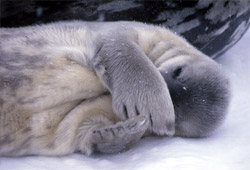 Weddell seals usually have their pups on sea-ice, getting in and out of the sea through a breathing hole. These breathing holes are guarded and kept open by the males during the time when the females give birth. The male guarding the hole will defend a territory beneath the ice against other males for access to mates. The females are ready to breed again shortly after the birth of the pup so the males that successfully defend a breathing hole will mate with the mother seals that use this hole, typically this will be a ratio of about 10 to one. Weddell seals usually have their pups on sea-ice, getting in and out of the sea through a breathing hole. These breathing holes are guarded and kept open by the males during the time when the females give birth. The male guarding the hole will defend a territory beneath the ice against other males for access to mates. The females are ready to breed again shortly after the birth of the pup so the males that successfully defend a breathing hole will mate with the mother seals that use this hole, typically this will be a ratio of about 10 to one. |
| 6/ How do Weddell seals manage to survive out on the open ice? How do they get to the sea? |
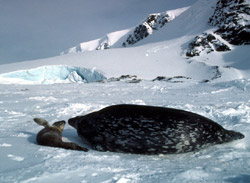 Weddell seals prefer to live on ice that is broken up somewhat, in this way there are often natural cracks and holes through the ice that they can use to get in and out of the sea. There are also holes and cracks around ice bergs that are trapped in sea-ice and often "tide-cracks" appear near when near land, all of these help.These holes are fine to begin with, but when temperatures are well below freezing, they begin to freeze up - quickly. The seals keep the holes open by rasping them with their teeth. They open their mouths wide and move their heads back and forward in a wide arc attacking the ice that is building up around the sides of the hole. This is a very fast and vigorous process that takes a lot of energy and a toll on the seals teeth. Weddell seals prefer to live on ice that is broken up somewhat, in this way there are often natural cracks and holes through the ice that they can use to get in and out of the sea. There are also holes and cracks around ice bergs that are trapped in sea-ice and often "tide-cracks" appear near when near land, all of these help.These holes are fine to begin with, but when temperatures are well below freezing, they begin to freeze up - quickly. The seals keep the holes open by rasping them with their teeth. They open their mouths wide and move their heads back and forward in a wide arc attacking the ice that is building up around the sides of the hole. This is a very fast and vigorous process that takes a lot of energy and a toll on the seals teeth.Keeping breathing holes open like this wears away the teeth of Weddell seals and it is this that means that the Weddells only live to about 18 years old, about half the life-span of a crabeater seal for instance. Weddells can swim great distances across apparently continuous sea-ice by detecting the natural cracks and holes along the way. When covering distance rather than fishing, they only dive to a shallow depth and find the next breathing hole in the gloom under the ice by sonar - they emit a series of high pitched sounds and pick up the difference in sound when the sounds reach a hole. |
| 7/ Do the pups take naturally to the water straight away? |
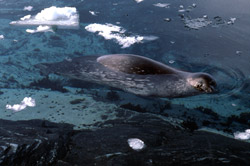 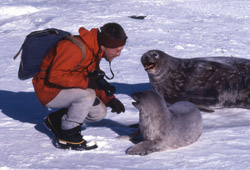 The first picture is of a juvenile Weddell seal weaned from its mother about 2 or 3 months previously and already completely in control in its aquatic environment. The scene a few months ago was rather different though. Weddell seal pups don't automatically realise that they can or should dive and the early attempts are amusing to watch. The first picture is of a juvenile Weddell seal weaned from its mother about 2 or 3 months previously and already completely in control in its aquatic environment. The scene a few months ago was rather different though. Weddell seal pups don't automatically realise that they can or should dive and the early attempts are amusing to watch."Attempts" is the wrong word. What actually happens is that the mother pushes the pup into the water against its will. She then pushes its head under the water - again against its will. There is much coughing, spluttering and panic before the pup realises that it can hold its breath under the water and that this in fact does help! The pups soon get the hang of it though and as adults will dive to up to 600 metres (2 000ft) or more staying under for up to an hour and going as much as 12 kilometres from the breathing hole. A typical feeding dive takes the seal to 200-400m and lasts for 5-25 minutes. |
| 8/ Weddell Seal (Leptonychotes wedelli) at breathing holes |
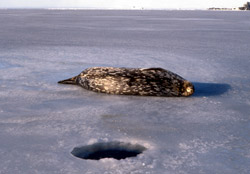 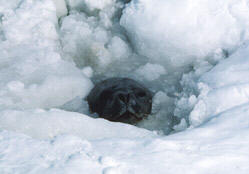 Weddell seals are very hardy, resourceful and quite remarkably behaviourally adapted for life in the Antarctic pack and fast-ice as these two pictures show. In the top picture, the seal has found a breathing hole through pieces of only partially consolidated pack-ice where there is a non-frozen portion that is nonetheless filled with slush. From below such a region will let considerably more light through than the thick pack-ice pieces and stand out like a beacon to a seal swimming by, even if it is solid, it will be thin and probably thin enough for the seal to break through. Weddell seals have no land-based predators and so there is no danger to them of coming up to such breathing holes, just the odd surprise if there's a wandering scientist nearby to capture the moment on camera. Weddell seals are very hardy, resourceful and quite remarkably behaviourally adapted for life in the Antarctic pack and fast-ice as these two pictures show. In the top picture, the seal has found a breathing hole through pieces of only partially consolidated pack-ice where there is a non-frozen portion that is nonetheless filled with slush. From below such a region will let considerably more light through than the thick pack-ice pieces and stand out like a beacon to a seal swimming by, even if it is solid, it will be thin and probably thin enough for the seal to break through. Weddell seals have no land-based predators and so there is no danger to them of coming up to such breathing holes, just the odd surprise if there's a wandering scientist nearby to capture the moment on camera.The lower picture is of a Weddell seal that has made a hole in apparently unbroken, though quite thin fast-ice and hauled out for a rest. We came across this seal while out several miles from the shore on recently formed and very hard and strong, but disconcertingly thin ice. In fact we didn't realise how thin the ice was until we came across this seal and the hole it had made. It was entirely unperturbed by a group of 5 people manhauling a heavily laden sledge with camping gear as we went off on our holidays and treated us as if we weren't really there at all. Seals probably live a fairly surreal life anyhow. |
| 9/ Why are the White Island Weddell seals special? |
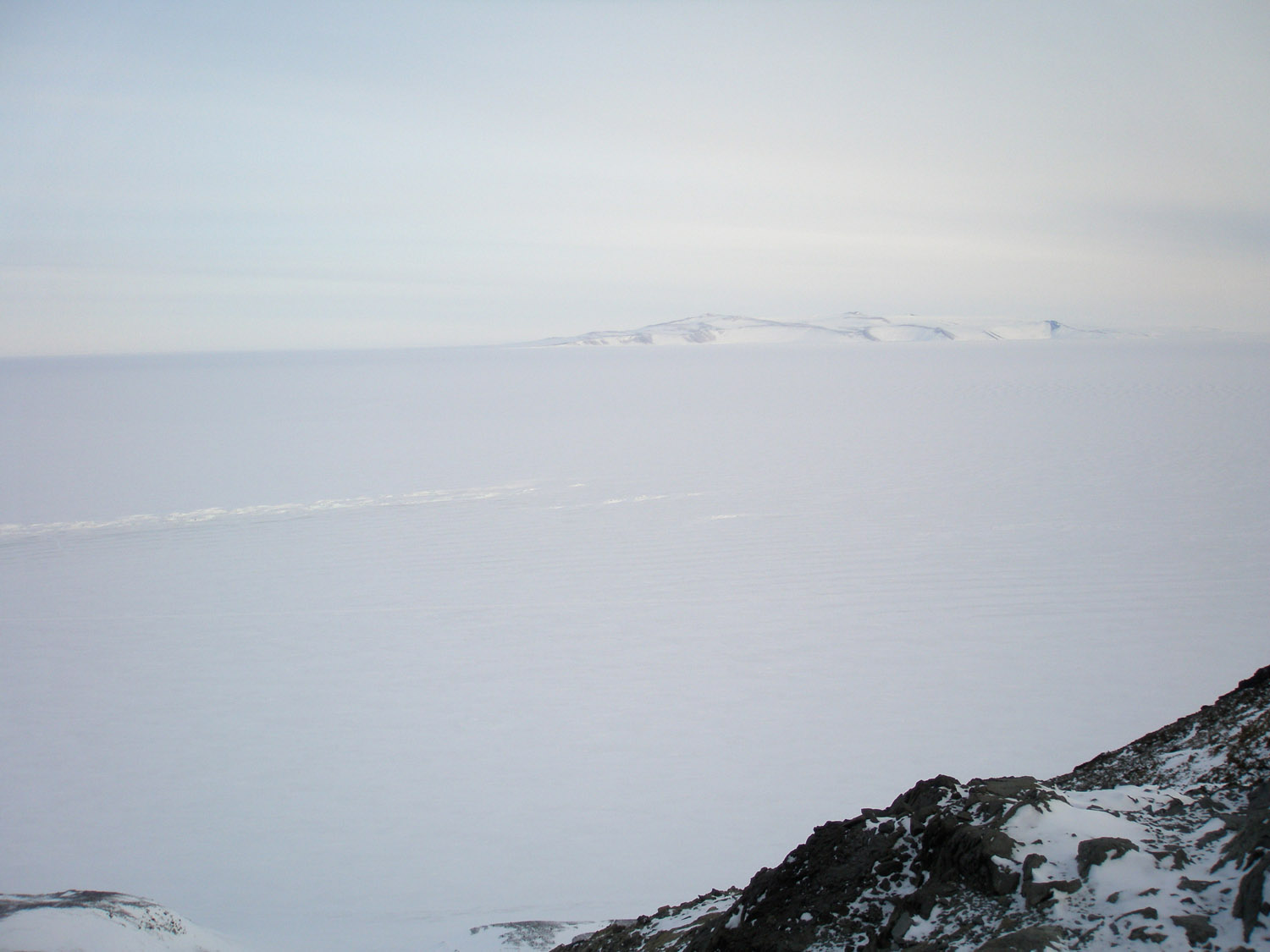 White Island is an Island in the Ross sea that has the most southerly population of Weddell seals. These seals are only 1 300 kilometres from the South Pole, but this is not the only remarkable thing about them.
White Island is an Island in the Ross sea that has the most southerly population of Weddell seals. These seals are only 1 300 kilometres from the South Pole, but this is not the only remarkable thing about them. They are isolated from the rest of the world as the nearest open sea for them to is too far under the very thick ice of the Ross ice shelf for them to get out.
These seals are thought to have travelled to this area between 50 and 100 years ago when a large chunk of permanent ice shelf broke off. They were then trapped when it reformed behind them and have remained here ever since. They use cracks in the ice immediately beside White Island to reach the sea, they must dive about 70 metres here through cracks in the ice before they get down to the open sea below. In the summer when the sea ice has broken up, it is still at least 22 kilometres to the next breath at the edge of the ice shelf, too far for the seals to manage.
So here they remain unable to leave the area and with a deep dive past walls of ice before they can even begin fishing.
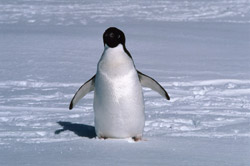
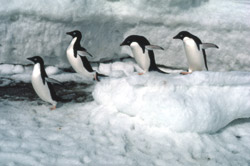
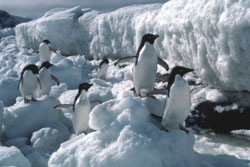
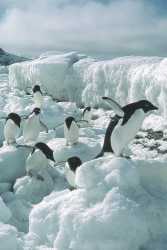
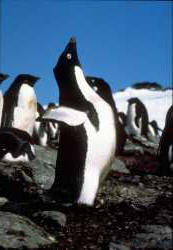
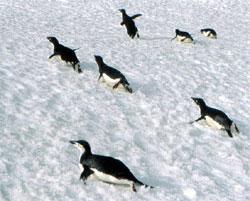
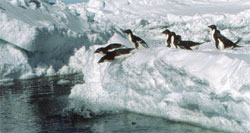
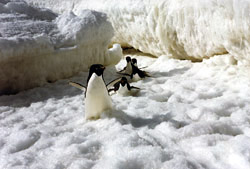 These penguins were walking, waddling and tobogganing up and down the area beneath the ice foot looking somewhere to get out. So I thought I'd play a little trick, squat down out of view and wait for them to turn the corner - no I didn't jump up and shout "surprise!", but the comic effect of the first bird's reaction to realising he was coming towards me at high speed is evident.
These penguins were walking, waddling and tobogganing up and down the area beneath the ice foot looking somewhere to get out. So I thought I'd play a little trick, squat down out of view and wait for them to turn the corner - no I didn't jump up and shout "surprise!", but the comic effect of the first bird's reaction to realising he was coming towards me at high speed is evident.